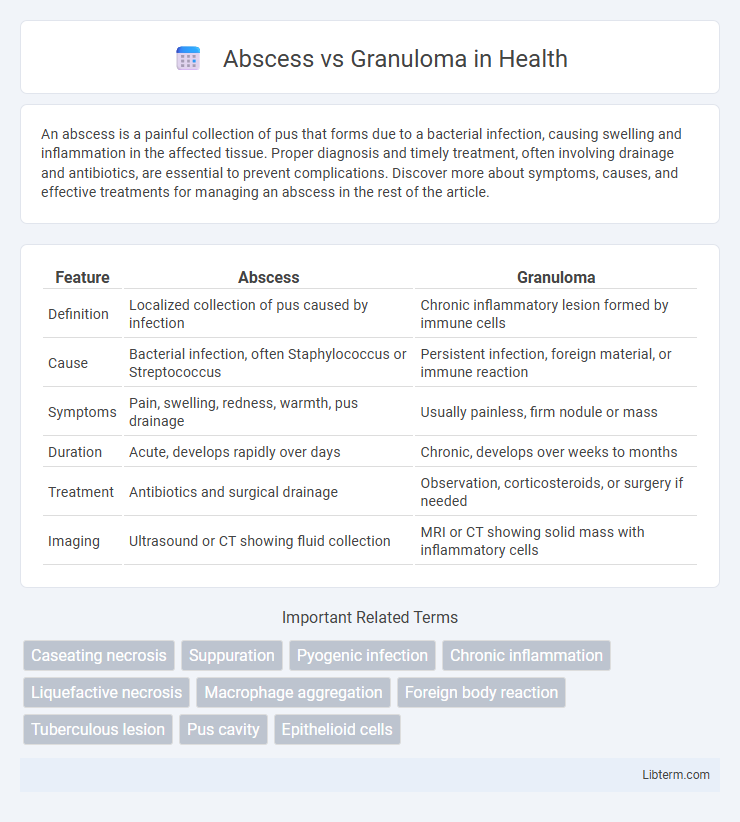An abscess is a painful collection of pus that forms due to a bacterial infection, causing swelling and inflammation in the affected tissue. Proper diagnosis and timely treatment, often involving drainage and antibiotics, are essential to prevent complications. Discover more about symptoms, causes, and effective treatments for managing an abscess in the rest of the article.
Table of Comparison
| Feature | Abscess | Granuloma |
|---|---|---|
| Definition | Localized collection of pus caused by infection | Chronic inflammatory lesion formed by immune cells |
| Cause | Bacterial infection, often Staphylococcus or Streptococcus | Persistent infection, foreign material, or immune reaction |
| Symptoms | Pain, swelling, redness, warmth, pus drainage | Usually painless, firm nodule or mass |
| Duration | Acute, develops rapidly over days | Chronic, develops over weeks to months |
| Treatment | Antibiotics and surgical drainage | Observation, corticosteroids, or surgery if needed |
| Imaging | Ultrasound or CT showing fluid collection | MRI or CT showing solid mass with inflammatory cells |
Introduction to Abscess and Granuloma
An abscess is a localized collection of pus caused by a bacterial infection, resulting in tissue destruction and inflammation. A granuloma is a chronic inflammatory response characterized by a cluster of macrophages, often forming to contain persistent pathogens or foreign substances. Understanding the distinction between abscess and granuloma is crucial for accurate diagnosis and targeted treatment in infectious and inflammatory conditions.
Definition: What is an Abscess?
An abscess is a localized collection of pus caused by a bacterial infection, characterized by tissue inflammation and necrosis. It forms as the immune system responds to pathogens, resulting in a swollen, painful, and often warm area filled with purulent material. Abscesses can occur in various tissues, including skin, organs, and internal cavities, requiring medical intervention for drainage and antibiotics.
Definition: What is a Granuloma?
A granuloma is a small area of chronic inflammation characterized by a collection of immune cells, primarily macrophages, that form in response to persistent irritants such as infections or foreign substances. Unlike an abscess, which contains pus due to acute infection, a granuloma encapsulates the offending agents to prevent their spread. Granulomas are commonly seen in diseases like tuberculosis, sarcoidosis, and certain fungal infections.
Key Differences Between Abscess and Granuloma
An abscess is a localized collection of pus caused by acute infection, characterized by pain, swelling, and redness, whereas a granuloma is a chronic inflammatory response with granulomatous tissue formed to contain persistent irritants like bacteria or foreign substances. Abscesses typically have a central necrotic area filled with neutrophils, while granulomas consist of organized macrophages, epithelioid cells, and multinucleated giant cells. Treatment approaches also differ: abscesses often require drainage and antibiotics, whereas granulomas may resolve with anti-inflammatory therapy or surgical removal depending on the underlying cause.
Causes and Risk Factors
Abscesses are typically caused by bacterial infections, leading to localized pus formation, often due to Staphylococcus aureus or Streptococcus species, with risk factors including poor hygiene, immune suppression, and trauma. Granulomas arise from chronic inflammatory responses to persistent irritants such as Mycobacterium tuberculosis, fungal infections, or foreign bodies, with risk factors including prolonged infection, autoimmune diseases, and exposure to certain pathogens. Both conditions involve immune system activation but differ significantly in their etiologies and pathological processes.
Clinical Presentation and Symptoms
An abscess typically presents as a painful, swollen, and erythematous mass accompanied by localized warmth, tenderness, and sometimes systemic symptoms such as fever or malaise. Granulomas often manifest as firm, painless nodules that develop slowly and may be asymptomatic or cause mild discomfort depending on their location. In clinical practice, abscesses are associated with acute infection signs, while granulomas represent chronic inflammatory responses with less pronounced systemic symptoms.
Diagnostic Approaches
Diagnostic approaches for abscesses primarily involve clinical examination, ultrasonography, and sometimes CT or MRI to identify localized pus collections and differentiate them from cellulitis. Granulomas require histopathological analysis through biopsy to detect aggregated macrophages and multinucleated giant cells indicating chronic inflammation, with imaging techniques like chest X-rays or CT scans aiding in identifying granulomatous lesions in organs. Laboratory tests, including culture and PCR, support diagnosis by detecting infectious agents causing abscesses or granulomatous diseases such as tuberculosis or sarcoidosis.
Treatment Options
Treatment options for abscesses typically involve incision and drainage combined with antibiotic therapy targeting common bacteria such as Staphylococcus aureus. Granuloma management focuses on addressing the underlying cause, often requiring corticosteroids or immunosuppressive drugs to reduce inflammation and promote healing. Surgical excision may be necessary for persistent or complicated granulomas that do not respond to medical treatments.
Prognosis and Complications
Abscesses typically have a favorable prognosis when promptly drained and treated with appropriate antibiotics, but delayed management can lead to complications such as systemic infection, sepsis, or tissue necrosis. Granulomas, being chronic inflammatory responses often caused by infections like tuberculosis or autoimmune diseases, may persist indefinitely and sometimes evolve into fibrosis or calcification, potentially impairing organ function depending on their location. The risk of granuloma complications includes chronic inflammation and tissue destruction, while abscess-related complications revolve primarily around the spread of infection and systemic inflammatory response.
Prevention and Patient Education
Preventing abscess formation involves proper wound care, maintaining skin hygiene, and early treatment of infections to avoid bacterial proliferation and pus accumulation. Granuloma prevention focuses on minimizing chronic inflammation by managing underlying infections or autoimmune conditions, and avoiding exposure to irritants like foreign bodies or persistent pathogens. Educating patients on recognizing early symptoms, adhering to treatment plans, and seeking timely medical evaluation reduces complications associated with both abscesses and granulomas.
Abscess Infographic

 libterm.com
libterm.com